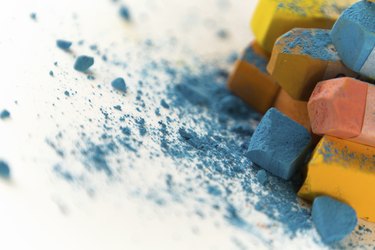
Sketches in chalk, pastels or charcoal share a common conundrum -- without a fixative, the drawing smears easily, ruining your work. Even a slight bump to the art piece may cause it to lose some of the chalk if it isn't "fixed" in place. Spray-on art fixatives designed specifically for chalky mediums offer the most reliable means of preserving chalk work, while artist's varnish offers an additional layer of protection.
Spray Fixatives
Video of the Day
A fixative protects powdery art mediums such as chalk, pastels and charcoal, whether they're painted on paper or other chalk-friendly surfaces. Spray fixatives are either workable or non-workable. A workable fixative means you can still draw atop the dried fixative without damaging your work. Drawing atop a non-workable fixative will pull up some of the fixative, and potentially the paper with it, turning your creation into a damaged mess. It's easy to tell which type of fixative is which, as the cans clearly state in large letters whether the substance is workable. Oil pastels should not be sealed with a standard fixative, as this type of pastel doesn't dry completely and will repel the typical fixative. Use a fixative designed for oil pastels -- or no fixative at all -- if working with oil pastels. No matter which fixative you choose, spray it on in fine coats, following directions on the can. Do not soak the paper, or you risk damaging your work.
Video of the Day
UV Protectants
Protection from ultraviolet rays helps ensure your artwork -- and the paper it is on -- stays the same color year after year. A UV-protectant spray used over a non-workable fixative provides extra protection for your work. Use a UV protectant designed specifically for artwork. Like paints and varnishes, the spray is available in both matte or glossy finishes, so be sure to read the can carefully to ensure you purchase the product intended for your work. Spray light bursts of the protectant over the fixative after the fixative is completely dry.
Spray-on Varnish
A varnish spray designed for artwork adds protection against moisture and humidity when used atop your fixative or UV-protectant spray. As with the other spray-on protective methods, apply thin, light coats once the previous layer of spray-on protection is dry. For best results, stick with the same brand of fixatives, UV protection and varnish if using all three on the same piece.
Hair Spray as Sealer
Hair spray is used by some artists to seal their chalk or pastel works in a pinch, since many of the ingredients are the same as what's found in the average spray fixative. The downside to hair spray is that other chemical additives designed to lubricate or add shine and nutrients to hair may leave oily marks on your work. The spray nozzle on a hair spray can is designed to coat hair quickly and evenly, but not to create the fine mist necessary for art projects. Hair spray, used as a fixative, also tends to yellow, flake or chip over time, which may also ruin your work.